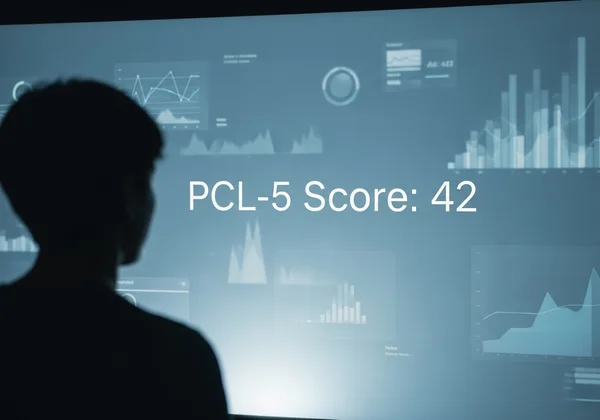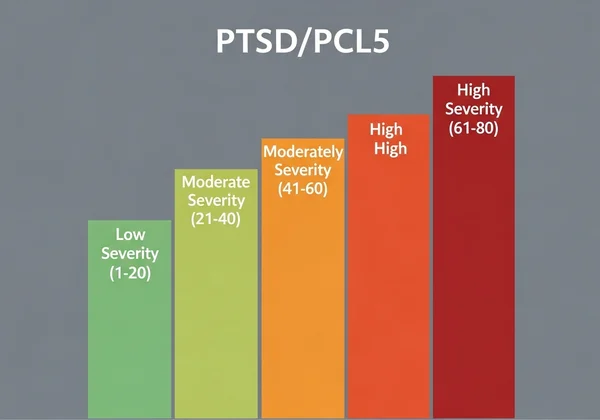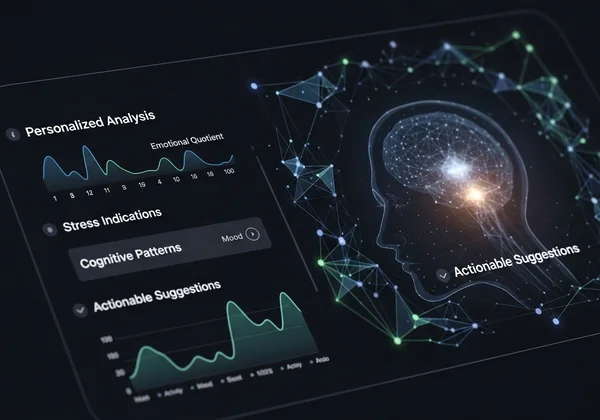PCL5 Score: Next Steps for PTSD Understanding & Support
Receiving your PCL5 score can bring a mix of emotions—perhaps relief, concern, or confusion. Taking this step is a sign of strength and self-awareness. But you might be asking, what do my PCL5 scores mean? This guide is here to walk you through understanding your results, empowering you with clear, actionable next steps for your journey toward healing and support. Your score provides clarity, but your actions define your path forward.
The PCL-5 (PTSD Checklist for DSM-5) is a respected screening tool, but it's just the beginning. It provides a snapshot of your symptoms over the past month. On our platform, we believe that understanding this snapshot is the first step. Whether you've just completed our confidential assessment or have a score from a clinician, let's explore what comes next. If you haven't taken the test yet, you can get your free score anytime.
Understanding Your PCL5 Score & Its Implications

Your PCL-5 score, ranging from 0 to 80, reflects the severity of the PTSD symptoms you've reported. It's calculated by summing the values (0-4) for each of the 20 questions. This number isn't a label but a tool to help you and potentially a mental health professional gauge the impact of trauma on your daily life. It helps organize your experiences into a clearer picture.
Think of it less as a final grade and more as a starting point for a conversation. A low score doesn't invalidate your experiences, and a high score is not a life sentence. It is simply a piece of data that can guide you toward the right kind of support and provide a baseline for measuring progress over time.
What Do Your PCL5 Scores Mean? (Severity Levels)
While not a formal diagnostic tool, the total PCL5 scoring severity can be broken down into general levels to help contextualize your experience. These ranges offer a guide for interpreting the intensity of your symptoms.
- 0-15 (Low): Scores in this range suggest few to no PTSD symptoms. You may have experienced a traumatic event, but its impact on your daily functioning appears minimal at this time.
- 16-32 (Mild to Moderate): This range indicates that you are likely experiencing some distressing symptoms that may be interfering with parts of your life. It’s a good time to consider self-care strategies and potentially monitor your symptoms.
- 33-45 (Moderate to High): A score in this range often suggests that PTSD symptoms are significantly affecting your well-being and daily life. It is highly recommended to seek a professional evaluation. This score is often used as a clinical cutoff for a provisional PTSD diagnosis.
- 46+ (High): Scores this high indicate severe and pervasive PTSD symptoms that are likely causing substantial distress and impairment in your relationships, work, and overall quality of life. Seeking professional help is crucial.
Is My PCL5 Score Considered High?

When asking "What is a high PCL5 score?", it's important to look at clinical guidelines. Research suggests a score of 31-33 is a common cutoff for indicating that a person's symptoms warrant a clinical assessment for PTSD. If your score is at or above this threshold, it’s a strong signal that speaking with a professional could be beneficial.
However, context is everything. A single score doesn't tell the whole story. It doesn’t capture your personal strengths, your resilience, or the specific nature of your trauma. That's why your score should be a catalyst for further exploration, not a conclusion.
Deciding Your Next Steps After a PCL5 Test
So, you have your score. Now what? The most important thing is to be kind to yourself. You've just processed challenging information. Your next steps should be about gathering more information and building a support system that works for you. Recovery is a journey, and acknowledging your score is a courageous first step.
Taking action after a PTSD test is about moving from awareness to empowerment. You can choose from several paths, and they are not mutually exclusive. Combining professional guidance with personalized insights can create a powerful strategy for healing.
Seeking Professional Mental health support
If your PCL-5 score indicates moderate to severe symptoms, or if you simply feel overwhelmed, seeking professional help is the most effective next step. A trained therapist, psychologist, or psychiatrist can provide a formal diagnosis and create a tailored treatment plan.
They can help you understand the root of your symptoms, teach you coping mechanisms, and guide you through evidence-based therapies. Remember, reaching out to a professional is a sign of courage and commitment to your well-being. It's a proactive step towards your well-being.
How Our AI Report Offers Deeper PTSD Insights
A score gives you the "what," but it doesn't always give you the "why" or "how." This is where our platform offers a unique advantage. Beyond the free score, you have the option to unlock a personalized AI-driven report that provides deeper PTSD insights.

This report goes beyond the numbers to give you:
- Personalized Analysis: It connects your specific symptoms to potential challenges in areas like relationships, work, and emotional regulation.
- Strengths & Challenges: It highlights not only your difficulties but also potential areas of resilience.
- Actionable Suggestions: The report provides concrete, personalized suggestions for coping strategies and self-care practices.
This tool is designed to bridge the gap between getting a score and starting your recovery. It provides a detailed, compassionate interpretation of your results, giving you a clearer roadmap. To learn more, unlock your AI report and gain a more complete understanding of your experience.
Exploring Effective PTSD Treatment Options & Coping Strategies
The path to managing PTSD is hopeful, with many proven strategies available. Recovery is not about erasing the past but about reducing the power that symptoms have over your present and future. Exploring PTSD treatment options and daily coping strategies can empower you to regain control.
Combining professional treatment with personal self-care is often the most effective approach. Therapy provides the framework and tools, while daily practices help you build resilience and manage symptoms moment-to-moment.
Evidence-Based Therapies for PTSD Recovery
Several evidence-based therapies have been proven highly effective for PTSD. A mental health professional can help determine which is right for you. Some of the most common include:
- Cognitive Processing Therapy (CPT): Helps you challenge and change unhelpful beliefs related to the trauma.
- Prolonged Exposure (PE) Therapy: Involves gradually approaching trauma-related memories, feelings, and situations to reduce their power.
- Eye Movement Desensitization and Reprocessing (EMDR): Uses bilateral stimulation (like eye movements) to help process and integrate traumatic memories.
Self-Care Practices and Building a Support System
Developing effective coping strategies is vital for managing symptoms day-to-day. These practices can help ground you and improve your overall well-being.
-
Mindfulness and Grounding: Practice simple exercises like deep breathing or the 5-4-3-2-1 technique to stay present when you feel overwhelmed.
-
Routine and Structure: Establishing a predictable daily routine can create a sense of safety and stability.
-
Connect with Others: Don't isolate yourself. Share your feelings with trusted friends, family, or a support group.
-
Healthy Lifestyle: Prioritize sleep, nutrition, and physical activity, as they all play a crucial role in mental health.

Building a strong support system is key. Let people in who are patient, understanding, and encouraging. Your healing journey doesn't have to be walked alone.
Your Journey to Understanding & Support Starts Now
Your PCL-5 score is a pivotal first step on your path to understanding and wellness. It’s a tool that provides clarity and direction, not a definition of who you are. By understanding what the score means and exploring your next steps, you are actively moving toward a healthier future.
Whether you choose to speak with a professional, explore our advanced AI report for a deeper understanding, or begin implementing new coping strategies, know that you are in control. The journey to managing trauma is one of courage, and you've already taken a brave and pivotal step towards a healthier future. Ready to begin? Take the PCL5 test today.
Frequently Asked Questions About Your PCL5 Score & Next Steps
Can the PCL5 diagnose PTSD?
No, the PCL-5 is a screening tool, not a diagnostic instrument. While it is a highly reliable measure of PTSD symptoms based on DSM-5 criteria, it cannot provide a formal diagnosis. Only a qualified mental health professional can conduct a comprehensive assessment to diagnose PTSD. Think of the PCL-5 as a smoke alarm: it alerts you to a potential issue, but you need a professional to confirm the fire and help put it out.
What are the 20 symptoms of PTSD mentioned in the PCL5?
The 20 questions on the PCL-5 correspond directly to the symptoms of PTSD outlined in the DSM-5. These fall into four main clusters:
- Intrusion Symptoms: Unwanted upsetting memories, nightmares, or flashbacks.
- Avoidance: Avoiding trauma-related thoughts, feelings, or external reminders.
- Negative Alterations in Cognition and Mood: Negative beliefs, distorted blame, or loss of interest in activities.
- Alterations in Arousal and Reactivity: Being irritable, jumpy, or having trouble sleeping. You can see the full list of questions when you start your PCL5 test on our platform.
Who should I talk to about my PCL5 score?
The best person to discuss your PCL-5 score with is a licensed mental health professional, such as a therapist, psychologist, or psychiatrist. They have the expertise to interpret your score in the context of your unique life experiences and provide guidance on next steps. You can also share it with a trusted primary care doctor, who can offer a referral. If you're not ready for that step, our optional AI-driven report is designed to help you make sense of your results in a confidential and supportive way.